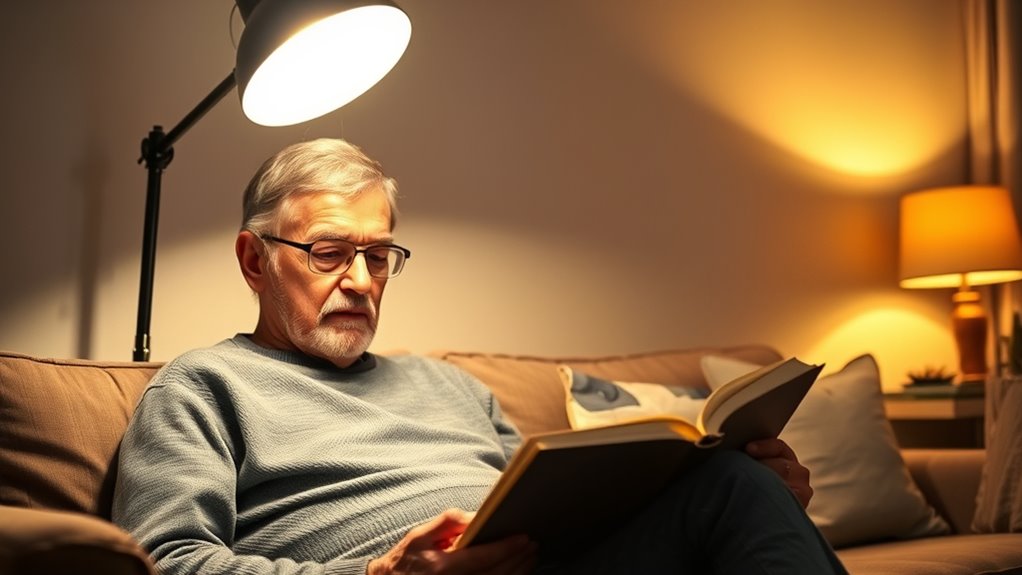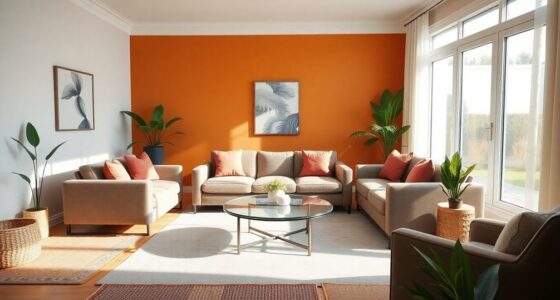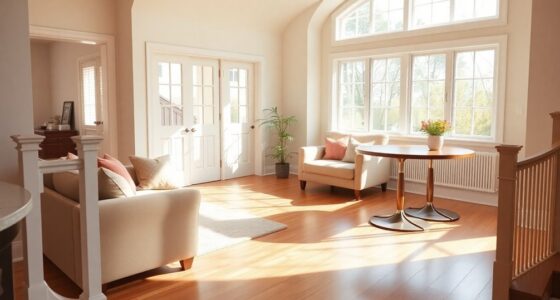To brighten your home for aging eyes, add layers of lighting like ambient, task, and accent options. Use adjustable fixtures and warm-colored bulbs to reduce glare and enhance contrast, making objects easier to see. Position lights to avoid reflections and shining directly into your eyes. Properly placed and soft lighting can lessen eye strain and boost visual clarity. Keep exploring how these lighting tips can transform your space into a more comfortable and accessible environment.
Key Takeaways
- Install adjustable, layered lighting to enhance contrast and reduce shadows for better visibility.
- Use warm-colored bulbs and soft, diffuse lighting to minimize glare and eye strain.
- Position task lights, like reading lamps, to direct illumination where needed without shining into eyes.
- Incorporate dimmable fixtures to control brightness levels and adapt lighting for different activities.
- Avoid harsh, direct lighting; instead, opt for ambient and accent lighting to create a comfortable, well-lit environment.

Have you noticed that reading or working in dim lighting becomes more difficult as you age? It’s a common issue that many people face, and it’s often linked to changes in your eyesight. As you get older, your eyes become less efficient at processing visual information, making it harder to distinguish objects and read fine print without additional light. This is where adding proper lighting can make a considerable difference. One key aspect is focusing on contrast enhancement, which helps your eyes distinguish between objects and their backgrounds more clearly. By increasing contrast, you make it easier to see details and reduce eye strain. For example, using lighting that highlights edges or creates a sharper difference between text and background boosts visual clarity. It’s especially helpful when reading or doing tasks that require fine detail, like sewing or working on a computer.
Enhance contrast in your lighting to see details clearly and reduce eye strain as you age.
Another important factor is glare reduction. Older eyes tend to be more sensitive to bright, direct light, which can cause discomfort and make it difficult to see clearly. Glare can wash out details and create visual confusion, so controlling it is essential for comfortable, effective lighting. When you add lights to your home, aim for fixtures that diffuse light evenly rather than produce harsh, direct beams. This minimizes glare and prevents your eyes from constantly adjusting to bright spots. Soft, ambient lighting combined with task lighting on work surfaces creates a balanced environment that reduces eye fatigue and enhances your ability to see comfortably.
To improve contrast enhancement and glare reduction, consider installing adjustable fixtures that allow you to control brightness levels. Use warm-colored bulbs, which are gentler on aging eyes, and position lights so they don’t shine directly into your eyes or reflect off shiny surfaces. For reading, a focused, directed light source like a desk lamp with a shade can help you see better without causing glare. In general, layering your lighting—combining ambient, task, and accent lights—creates a visually comfortable space that adapts to your needs throughout the day. This approach not only makes everyday activities easier but also helps you avoid unnecessary eye strain and fatigue.
Ultimately, by paying attention to contrast enhancement and glare reduction, you can profoundly improve your home’s lighting. Proper illumination makes a world of difference in maintaining your independence and comfort as your eyesight changes. It’s a simple step that transforms your living space into a brighter, more functional environment, ensuring you see clearly and comfortably, no matter your age.
Frequently Asked Questions
What Types of Lighting Are Best for Aging Eyes?
When choosing lighting for aging eyes, you should prioritize LED fixtures with a higher color temperature, around 3000K to 4000K, for better clarity. These lights reduce eye strain and enhance visibility. You also want fixtures that provide even, glare-free illumination. Avoid harsh, flickering lights and instead opt for adjustable options so you can tailor brightness as needed, making it easier to see details and perform daily tasks comfortably.
How Can I Reduce Glare From New Lighting?
Did you know that glare can reduce visibility by up to 40%? To minimize glare, focus on glare reduction techniques like adjusting light placement. Position lights so they don’t shine directly into your eyes, and use diffusers or lampshades to soften harsh light. Also, consider using dimmable lights to control brightness easily. Proper light placement and glare reduction can make your space safer and more comfortable for aging eyes.
Are Smart Lights Suitable for Aging Eye Needs?
Smart lights are a great option for aging eyes because they often feature adjustable color temperature, helping you find a comfortable, glare-free lighting level. Voice control makes it easy to change settings without moving around, reducing strain. You can switch to warmer tones for relaxing environments or brighter, cooler lights for tasks. These features support better eye comfort and visibility, making smart lights suitable for aging eye needs.
How Do I Balance Ambient and Task Lighting?
Your lighting design can feel like a balancing act, but with the right approach, you’ll master it effortlessly. To balance ambient and task lighting, layer different light sources—use soft, energy-efficient ambient lights to set the mood and focused task lights for activities. This not only enhances visibility but also boosts energy efficiency. Find the perfect mix, and your space will shine brighter and feel more inviting, even during the gloomiest days!
What Safety Precautions Should I Consider With New Lighting?
When installing new lighting, prioritize safety by guarantee proper light fixture placement to prevent accidental contact or falls. Always check electrical safety, like turning off power before wiring and using waterproof fixtures in damp areas. Avoid overloading circuits, and secure fixtures firmly. If unsure, consult a professional. These precautions help protect you from electrical hazards and ensure your lighting setup remains safe and functional.
Conclusion
By adding lights, you’re not just illuminating your space—you’re shining a beacon of clarity in the fog of aging. Each bulb becomes a symbol of empowerment, guiding you safely through your home’s shadows. As you brighten your surroundings, you reclaim independence and confidence, transforming darkness into a canvas for new beginnings. Remember, a well-lit home isn’t just about visibility; it’s about illuminating your life’s journey with hope and resilience.









